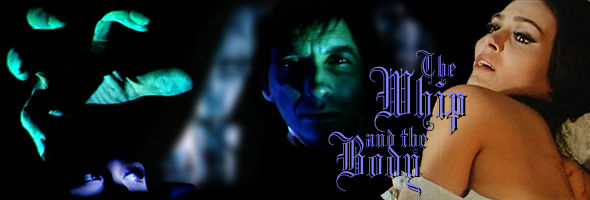
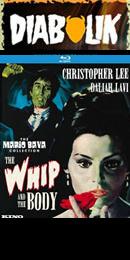

Color, 1963, 87m.
Directed by Mario Bava
Starring Dahlia Lavi, Christopher Lee, Tony Kendall, Gustavo De Nardo, Isli Oberon, Harriet White Medin
Kino Lorber (Blu-ray & DVD) (US RA/R1 HD/NTSC) / WS (1.78:1) (16:9), e-m-s (DVD) (Germany R0 PAL) / WS (1.85:1) (16:9), VCI (DVD) (US R1 NTSC) / WS (1.85:1)
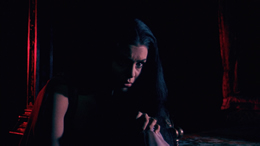
The most overtly sexual and challenging of Mario Bava's gothic masterpieces,
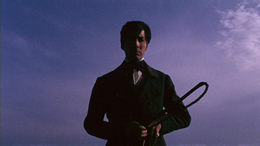 The Whip and the Body was released the same year as his far more famous Black Sabbath and was largely overshadowed, largely due to rampant censorship difficulties. Its essential unavailability well into the 1980s resulted in growing rumors among fans of extreme S&M-themed horror, and thanks to home video, slightly differing versions began to surface ranging from the original European cut on Japanese laserdisc to an essentially complete U.S. edition (under the title What!) with alternate opening credits. While the titular mixture of lashings and lust make it tread closer to roughie territory than one might expect from Bava, it's really not explicit and could run on television uncut now. That said, it's still an intoxicating experience and an essential entry in the history of Italian horror.
The Whip and the Body was released the same year as his far more famous Black Sabbath and was largely overshadowed, largely due to rampant censorship difficulties. Its essential unavailability well into the 1980s resulted in growing rumors among fans of extreme S&M-themed horror, and thanks to home video, slightly differing versions began to surface ranging from the original European cut on Japanese laserdisc to an essentially complete U.S. edition (under the title What!) with alternate opening credits. While the titular mixture of lashings and lust make it tread closer to roughie territory than one might expect from Bava, it's really not explicit and could run on television uncut now. That said, it's still an intoxicating experience and an essential entry in the history of Italian horror.Cloistered in a seaside castle,the Menliff family is torn asunder by the return of black sheep son Kurt (Lee), a sadistic brute whose savage treatment of a local girl forced him to be banished years earlier. Meanwhile his former fiancee, Nevenka (Lavi), has married his nice guy brother, Christian (Kendall), and become unnaturally close with her father-in-law (De Nardo). The housekeeper, Giorgia (Medin), still resents Kurt's treatment of her daughter, who committed suicide with an ornate dagger now displayed in proper fetish fashion in a glass case. Angry over his father's continued denial to grant him status as an heir, Kurt meets Nevenka on the beach and whips her furiously with a riding crop, an ordeal she accepts and apparently enjoys... but their twisted relationship is cut
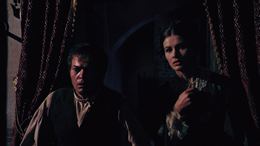 short that
short that 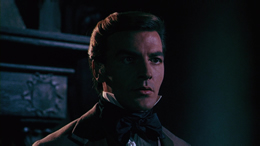 evening when Kurt is stabbed to death. Though Kurt's body is entombed, Nevenka begins to experience spectral encounters in which he enters her bedroom and whips her savagely. Strange deaths continue, and as the family deteriorates, the sadistic spirit of Kurt seems to hold sway over everyone involved.
evening when Kurt is stabbed to death. Though Kurt's body is entombed, Nevenka begins to experience spectral encounters in which he enters her bedroom and whips her savagely. Strange deaths continue, and as the family deteriorates, the sadistic spirit of Kurt seems to hold sway over everyone involved. Despite the potentially perverse subject matter, The Whip and the Body treats its subject with a finely restrained, poetic touch enhanced by Lavi's feverish expressions, which still convey a palpable sense of delirium, hunger, and confusion. Likewise, Lee is an imposing and memorable presence in a rare appearance as a sexual predator and spirit, lurking in the shadows and rising occasionally into Bava's unmistakable pools of hellish green and blue lighting. Composer Carlo Rustichelli takes a break here from his standard lounge-oriented scores to provide an elegant, neoclassical score (partially recycled in Kill Baby, Kill) in keeping with the off-kilter romanticism of the film, rising to an appropriate crescendo during the memorable climax. Newcomers to Bava would be advised to start elsewhere, but those already acquainted with the conventions of Italian gothic should find this most impressive.
After years of scratchy, faded transfers, VCI's DVD released in 2000 was a breath of fresh air, derived from a European source with the original opening titles on red satin. The U.S. credits were also included as a supplement. Unfortunately it was also non-anamorphic, but for the time it was a major upgrade. Though all versions of the film were dubbed, the English dialogue track is just as acceptable as the Italian one, with optional English subtitles translated from the Italian also included for comparison. Video Watchdog's Tim Lucas also returned for another multi-layered, finely arranged commentary track.
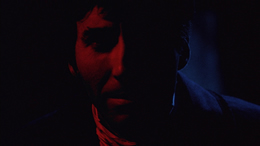 Including more humorous asides than usual, he offers a breezy tour through Bava's gallery of morbid imagery with a sure hand, pointing out trivia about even the smallest background players and discussing a multitude of technical aspects. In particular, he offers nice quotes from his chats with screenwriter Ernesto Gastaldi and points out one murder in the film that really makes no sense at all. The DVD also contains a French trailer (under the title Le corps et le fuet, sans subtitles) along with trailers for Blood and Black Lace and, most surprisingly, Bava's magnificent Planet of the Vampires, plus a gallery of photos and posters.
Including more humorous asides than usual, he offers a breezy tour through Bava's gallery of morbid imagery with a sure hand, pointing out trivia about even the smallest background players and discussing a multitude of technical aspects. In particular, he offers nice quotes from his chats with screenwriter Ernesto Gastaldi and points out one murder in the film that really makes no sense at all. The DVD also contains a French trailer (under the title Le corps et le fuet, sans subtitles) along with trailers for Blood and Black Lace and, most surprisingly, Bava's magnificent Planet of the Vampires, plus a gallery of photos and posters. Ignoring a bootleg version from Midnight Choir released in 2009 and quickly discontinued, the most attractive option on DVD actually came from Germany in 2005 under the title Der dämon und die jungfrau, complete with a much sharper anamorphic transfer and audio options in Italian, English and German with optional German subs, plus alternate openings (English and Italian) and theatrical trailers (German, Italian and French). As with many other titles of the period (most significantly Black Sabbath), the Italian prints were timed far more on the golden side with a sunnier appearance far different from the IB Technicolor versions released internationally; that was the source here, and it's easily the brightest edition around, for better or worse.
Now we jump ahead to 2013 with a Blu-ray release and DVD reissue from Kino Lorber as part of their ongoing Mario Bava line, and it's one of the few (alongside Hatchet for the Honeymoon) not licensed from Alfredo Leone. As you'd probably expect, right off the bat the transfer is yet another variant in the film's odd home video history and looks the closest to date to the Technicolor prints seen in most English-speaking territories. It's appropriately dark and rich with very crisp detail, causing the sparing but dramatic bursts of red and blue lighting to really pop off the screen. The frame grabs here are all from the Blu-ray, and while it really plays more beautifully in motion than a simple image can convey, it might at least give you some idea of what to expect. Most surprisingly, this is also one of the cleanest-looking Bava releases they've turned out to date, thanks to what appears to be a pristine French print (based on the opening credits). The 1.78:1 framing also adds a significant amount of information on the sides compared to the German disc, especially at the bottom. The PCM mono audio is presented in English, Italian and French with optional English subs translated from the Italian version, and Tim Lucas' commentary makes a welcome return and still holds up just as well. Additional extras include the French trailer for the main feature (looking pretty dupey as always) and bonus previews for Black Sabbath, Baron Blood, Bay of Blood, Lisa and the Devil and House of Exorcism. Bava hasn't exactly had the smoothest history on Blu-ray to date, but you can easily file this one among the winners and rank it as the most satisfying, impressive presentation of this often mistreated macabre gem to date.
Updated review on November 21, 2013.
![]()